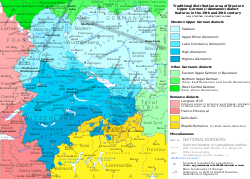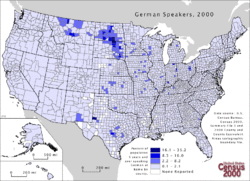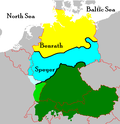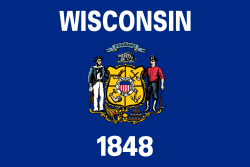of German was considerably reduced. Significant dialects such as the East Pomeranian dialect, most varieties of Silesian German, Prussian dialects and...
24 KB (2,825 words) - 01:45, 3 June 2025
Low German has not undergone the High German consonant shift, as opposed to Standard High German, which is based on High German dialects. Low German evolved...
116 KB (8,316 words) - 05:17, 30 May 2025
Palatine German (Standard German: Pfälzisch [ˈp͡fɛlt͡sɪʃ] , endonym: Pälzisch) is a group of Rhine Franconian dialects spoken in the Upper Rhine Valley...
8 KB (617 words) - 20:19, 11 May 2025
rarely Alemannish (Alemannisch, [alɛˈman(ː)ɪʃ] ), is a group of High German dialects. The name derives from the ancient Germanic tribal confederation known...
16 KB (1,268 words) - 20:30, 24 May 2025
Standard German is based on a combination of Thuringian-Upper Saxon and Upper Franconian dialects, which are Central German and Upper German dialects belonging...
144 KB (14,663 words) - 08:35, 4 June 2025
Bavarian language (redirect from Austro-Bavarian dialects)
000 sq mi), making it the largest of all German dialects. In 2008, 45 percent of Bavarians claimed to use only dialect in everyday communication. Bavarian...
27 KB (2,187 words) - 04:59, 2 June 2025
the first ethnically German families settled in the United States in Jamestown, Virginia, in 1608, the German language, dialects, and different traditions...
56 KB (5,581 words) - 23:42, 2 June 2025
Christoph Gottsched) and East Franconian German. East Central German dialects are mainly spoken in Central Germany and parts of Brandenburg, and were formerly...
7 KB (486 words) - 11:51, 16 May 2025
Hessian (German: Hessisch) is a West Central German group of dialects of the German language in the central German state of Hesse. The dialect most similar...
8 KB (771 words) - 02:52, 21 October 2024
dialects in other countries is restricted or even endangered. The dialects that comprise Swiss German must not be confused with Swiss Standard German...
72 KB (7,922 words) - 14:17, 23 May 2025
southern dialects experience the shift of voiced to voiceless stops, with the shift of /d/ to /t/ found in Upper German and in some Central German dialects, while...
32 KB (3,054 words) - 07:09, 3 April 2025
and Dresden. Austria High German (Hochdeutsch in Österreich, not to be confused with the Bavarian Austria German dialects) has the same geographic origin...
26 KB (2,543 words) - 20:51, 17 May 2025
which modern dialect maps are based. For this reason the dialects may be termed "monastery dialects" (German Klosterdialekte). The main dialects, with their...
45 KB (4,569 words) - 13:17, 25 May 2025
"Alsatian German"; Lorraine Franconian: Elsässerdeitsch; French: Alsacien; German: Elsässisch or Elsässerdeutsch) is the group of Alemannic German dialects spoken...
22 KB (1,545 words) - 15:42, 31 May 2025
The High German languages (German: hochdeutsche Mundarten, i.e. High German dialects), or simply High German (Hochdeutsch [ˈhoːxˌdɔɪ̯t͡ʃ] ) – not to be...
11 KB (927 words) - 07:28, 16 May 2025
assimilated. Some Volga German dialects are very similar to Pennsylvania Dutch, another Palatine Rhine Franconian language; in either dialect, one could say:...
45 KB (4,414 words) - 08:30, 25 May 2025
more widely understood than other dialects and as a Central German dialect, was felt to be "halfway" between the dialects of the north and south. Luther...
42 KB (3,673 words) - 17:07, 1 April 2025
north-eastern Germany as well as by minorities in northern Poland. Together with West Low German dialects, it forms a dialect continuum of the Low German language...
8 KB (765 words) - 23:22, 15 May 2025
dialects, with locally varying degrees of influence of the initial dialects. Swabian can be difficult to understand for speakers of Standard German due...
19 KB (1,403 words) - 01:50, 21 October 2024
Georgian dialects German dialects Malayalam languages Varieties of Malay Connacht Irish, Munster Irish, Ulster Irish Italian dialects Japanese dialects Korean...
63 KB (7,155 words) - 08:19, 25 May 2025
Linguistically, Yiddish is divided in distinct Eastern and Western dialects. While the Western dialects mostly died out in the 19th-century due to Jewish language...
24 KB (2,326 words) - 13:58, 6 May 2025
Moravian dialects are considerably more varied than the dialects of Bohemia, and span a dialect continuum linking Bohemian and West Slovak dialects. A popular...
26 KB (2,080 words) - 19:36, 29 May 2025
The Lusatian dialects (Standard German: Lausitzisch) are East Central German (High German) dialects spoken in southern Brandenburg and eastern Saxony....
2 KB (178 words) - 16:21, 2 September 2024
East Central dialects are the closest to Standard German (chiefly as a written language) among other German dialects. Modern Standard German thus evolved...
5 KB (297 words) - 09:25, 22 May 2025
of very closely related dialects, or variants, of the Ripuarian group of dialects of the Central German group. These dialects are spoken in the area covered...
16 KB (1,870 words) - 15:51, 27 May 2025
Moravian German dialects were moribund dialects of German spoken in Moravia in what is now the Czech Republic. Speakers of the dialect were largely expelled...
7 KB (823 words) - 22:59, 12 September 2024
dialects Austro-Bavarian dialects East Franconian German South Franconian German Kurt Gustav Goblirsch: Consonant Strength in Upper German Dialects....
12 KB (798 words) - 17:14, 21 April 2025
Low Saxon (redirect from West Low German language)
as West Low German (German: Westniederdeutsch) are a group of Low German dialects spoken in parts of the Netherlands, northwestern Germany and southern...
7 KB (606 words) - 19:39, 28 May 2025
The term Wisconsin German refers to both Wisconsin High German and to heritage dialects of German spoken in Wisconsin.: 5 By 1853, a third of Wisconsin's...
16 KB (1,670 words) - 21:18, 7 January 2025
Standard German which greatly influenced the vocabularies of these border dialects. Though the internal dialect continua of both Dutch and German remain...
52 KB (5,706 words) - 13:10, 25 May 2025


















